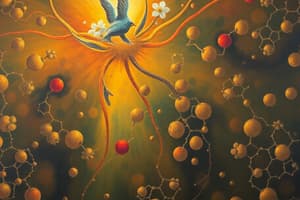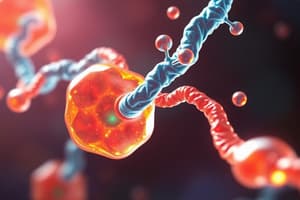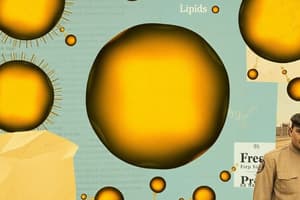Podcast
Questions and Answers
Which statement accurately describes the chemical properties of lipids?
Which statement accurately describes the chemical properties of lipids?
- Lipids are primarily composed of C, H, and O atoms with a 1:2 H:O ratio.
- Lipids are heterogeneous compounds primarily soluble in nonpolar solvents. (correct)
- Lipids are always polymers composed of repeating monomers.
- Lipids dissolve easily in polar solvents such as water.
What is the primary biological role of lipids in the human body?
What is the primary biological role of lipids in the human body?
- They are integral for carbohydrate metabolism.
- They serve as the main source of energy storage. (correct)
- They are primarily involved in the synthesis of nucleic acids.
- They act as the building blocks for proteins.
What is a defining characteristic of saturated fatty acids?
What is a defining characteristic of saturated fatty acids?
- They are fully saturated with hydrogen atoms. (correct)
- They are primarily found in plant oils.
- They contain one or more double bonds in their structure.
- They are generally liquid at room temperature.
How much body mass do lipids typically represent in adults?
How much body mass do lipids typically represent in adults?
Which statement about the structure of lipids is incorrect?
Which statement about the structure of lipids is incorrect?
What is a primary function of lipids in relation to energy storage?
What is a primary function of lipids in relation to energy storage?
Which lipid classification system is based on the chemical reaction known as saponification?
Which lipid classification system is based on the chemical reaction known as saponification?
What role do glycolipids predominantly play within biological membranes?
What role do glycolipids predominantly play within biological membranes?
What characteristic of fatty acids makes them amphipathic?
What characteristic of fatty acids makes them amphipathic?
What is a key function of steroid hormones derived from lipids?
What is a key function of steroid hormones derived from lipids?
Flashcards
Lipids
Lipids
Heterogeneous group of organic compounds, related to fatty acids and including fats, oils, waxes, and others.
Fatty Acids
Fatty Acids
Lipids related to fats and oils.
Saturated Fatty Acids (SFAs)
Saturated Fatty Acids (SFAs)
Fatty acids with no double bonds between carbon atoms.
Unsaturated Fatty Acids (USFAs)
Unsaturated Fatty Acids (USFAs)
Signup and view all the flashcards
Hydrophobic
Hydrophobic
Signup and view all the flashcards
Biomolecules
Biomolecules
Signup and view all the flashcards
Adipose tissue
Adipose tissue
Signup and view all the flashcards
Biological membranes
Biological membranes
Signup and view all the flashcards
Biological Importance of Lipids
Biological Importance of Lipids
Signup and view all the flashcards
Lipid Energy Storage
Lipid Energy Storage
Signup and view all the flashcards
Membrane Structure
Membrane Structure
Signup and view all the flashcards
Saponifiable Lipids
Saponifiable Lipids
Signup and view all the flashcards
Non-Saponifiable Lipids
Non-Saponifiable Lipids
Signup and view all the flashcards
Fatty Acids (FAs)
Fatty Acids (FAs)
Signup and view all the flashcards
Fatty Acid Structure
Fatty Acid Structure
Signup and view all the flashcards
Fatty Acid General Formula
Fatty Acid General Formula
Signup and view all the flashcards
Study Notes
Lipids Overview
- Lipids are molecules produced by living organisms.
- Major organic biomolecules include lipids, nucleic acids, carbohydrates, and proteins.
- Minerals and vitamins are also considered biomolecules.
- Structure and function of biomolecules are fundamentally related and influenced by environmental factors.
- Lipids are a diverse group of organic compounds related to fatty acids.
- Fats, oils, waxes, and other compounds are included in this group.
- Lipids are oily and greasy, and are not soluble in water.
- Polar solvents dissolve lipids.
- The predominant ingredient in lipids is the hydrocarbon chain.
- Lipids are not polymer structures made up of monomers.
- Lipids make up 18-25% of an adult's body mass.
- Lipids are primarily found in plasma, biological membranes, and adipose tissue.
- Adipose tissue: loose connective tissue designed to store fat in adipocytes (fat cells) found under the skin, around the kidneys, and in the abdomen and breasts.
- Adipose tissue functions: reserve fuel, insulation against heat loss, and support/protection of organs.
Biological Importance of Lipids
- Lipids act as structural components of biological membranes and nerves.
- They include glycolipids, phospholipids, sphingomyelins, cholesterol, and lipoproteins.
- Lipids maintain membrane fluidity.
- Lipids are a valuable energy reservoir.
- Stored lipids are the chief form of energy in the body and are more palatable and storable compared to carbohydrates.
- Lipid oxidation produces twice the energy produced from carbohydrates.
- Lipids insulate the body from heat loss by acting as a thermal insulator in subcutaneous tissues.
- Lipids act as a protective cushion for internal organs and are a protective coat for many organisms.
- Lipids are involved in cell-cell adhesion, cell recognition, and tissue immunity (glycolipids).
- Lipids such as bile acids and lecithins aid in the digestion and absorption of dietary fats.
- Lipids act as crucial cellular metabolic regulators, modulators of intracellular messengers, and intracellular messengers (steroid hormones, prostaglandins, inositol triphosphate (IP3)).
- Lipids provide the body with fat-soluble vitamins (A, D, E, and K) and essential fatty acids.
- Lipids are components of the electron transport chain (ubiquinone: coenzyme Q).
Classification of Lipids
- Saponification Classification System: Based on a chemical reaction called saponification (lipid undergoes ester hydrolysis in a basic condition (KOH)).
- Saponifiable: triglycerides, waxes, phospholipids, glycolipids
- Non-saponifiable: steroids, terpenes, vitamins, eicosanoids
- Bloor's Classification System: Based on the chemical composition of lipids.
- Simple lipids: fats and oils, waxes
- Compound lipids: phospholipids, glycolipids, lipoproteins, glycerophospholipids, sphingophospholipids, glyceroglycolipids, glycosphingolipids,
- Derived lipids: steroids, fatty acids, terpenes, carotenoids
Fatty Acids (FAs)
-
FAs are aliphatic monocarboxylic organic acids.
-
FAs contain a hydrocarbon chain with one carboxylic group at one end.
-
FAs are amphipathic, possessing both hydrophilic (water-soluble) and hydrophobic (water-insoluble) regions.
-
They have a carboxyl group (-COOH) and a hydrocarbon chain (R group).
-
More than 100 different FAs occur naturally.
-
Most FAs occur as esters (not free).
-
Most FAs are commonly synthesized from the condensation of 2-carbon units (acetate).
-
In most biological systems, FAs have an even number of carbon atoms (4-36); odd numbers occur less frequently.
-
FAs are typically straight and unbranched, but some have branched or heterocyclic chains.
-
They are classified as short, medium, or long chain depending on the number of carbon atoms in their hydrocarbon chain.
-
Saturated FAs: have no double bonds within their hydrocarbon chains.
-
Unsaturated FAs: contain one or more double bonds within their hydrocarbon chains.
-
The presence or absence of double bonds determines the degree of saturation.
-
Nomenclature: Fatty acids can be numbered from the carboxyl end or methyl end.
Structure and Properties of Saturated Fatty Acids
- Short-chain FAs (≤10 carbons) are water-soluble and volatile.
- Long-chain FAs (>10 carbons) are water-insoluble, non-volatile, and solid at room temperature.
- Saturated FAs are common in animals and plants.
- Examples of saturated FAs include palmitic acid (16:0) and stearic acid (18:0).
- Longer chains result in higher melting points.
- The higher melting point is a result of the increased energy required to disrupt hydrophobic interactions between saturated fatty acid molecules.
- Saturated FA sources include butter, cheese, chocolate, coconut, egg yolk, lard, meat, milk, palm oil, poultry, vegetable shortening, margarine, and salad dressings.
Studying That Suits You
Use AI to generate personalized quizzes and flashcards to suit your learning preferences.




